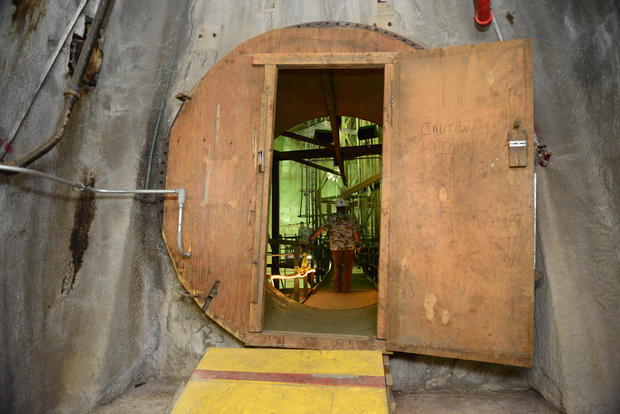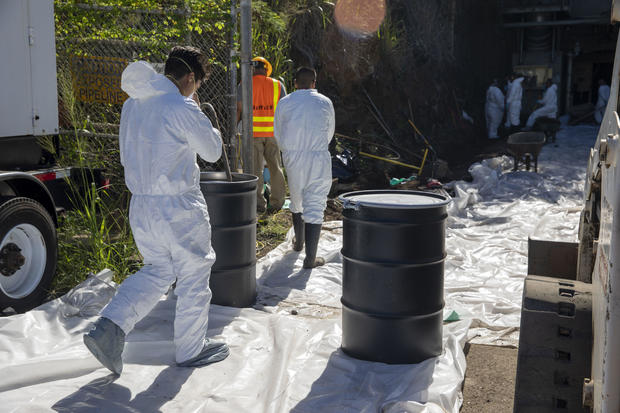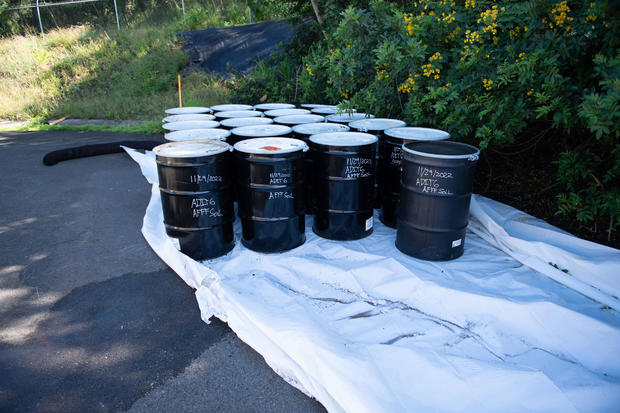Hawaii's 2021 Red Hill jet fuel leak sickened thousands — but it wasn't the first: "The system has failed us"
The week of Thanksgiving in 2021 quickly turned from one of fun with family and friends to something described as "post-apocalyptic" on the Hawaiian island of Oahu. Jet fuel had unknowingly leaked from the Department of Defense's largest underground fuel storage facility and seeped into the system that provides drinking water to thousands of military families and area residents.
Within days, "we were all fighting over water," Mai Hall, who is Native Hawaiian and a military spouse, told CBS News.
"It was all over the neighborhood. … I was crying putting tape over the faucets because I just could not believe that I couldn't drink the water, water that has been here for centuries," she said. "...The system has failed us."
Hall's family is one of many still feeling the impacts of that jet fuel exposure even today. But that leak wasn't the first that has occurred at the U.S. Navy's Red Hill Bulk Fuel Storage Facility — and it wasn't the last.

Red Hill's long history of issues and warnings
The Red Hill Bulk Fuel Storage Facility was built in the early 1940s under a mountain ridge near Honolulu, Hawaii's capital city, and consists of 20 steel-lined tanks encased in concrete. Each of those tanks is 250 feet tall, 100 feet in diameter and can hold roughly 12.5 million gallons of fuel — large enough to fit the Statue of Liberty from the top of the base to the torch.
Ernest Lau, manager and chief engineer of the Honolulu Board of Water Supply, told CBS News that the Navy's records show at least 72 documented fuel releases from the facility.
"Probably over 180,000 gallons of fuel of different types that has been released over its 80-year history," Lau said.
Navy Closure Task Force–Red Hill, which is overseeing the defueling and permanent closure of the site, told CBS News that while reports have identified approximately 70 fuel releases since the site was opened in 1942, the Navy has "accepted 58 of those claims" as part of a 2021 Contested Case Hearing. The Navy is working on confirming the number of releases of fuel and aqueous film forming foam (AFFF) —a fire suppressant that contains PFAS, otherwise known as "forever chemicals" that have been linked to a wide range of health issues, including cancers.

The most recent of those major fuel spills was in the fall of 2021, impacting Hall's family. Initial reports from the Navy indicated there was a spill of 14,000 gallons at this time, but it was later determined that 19,377 gallons of jet fuel spilled when a cart hit and cracked a fire suppression system pipe that had been containing the fuel since it leaked out of a tank earlier in the year.
But two years before that, a risk analysis conducted by the Navy found a 27.6% chance "of an initiating event resulting in a fuel release between 1,000 and 30,000 gallons."
That analysis was conducted after a spill was announced at the facility on Jan. 13, 2014, which at the time was holding three types of fuel — JP-5, JP-8 and diesel marine fuel, all of which are known to be harmful to human health when chronically exposed. The leak occurred when one of the underground tanks "experienced a release of 27,000 gallons of fuel due to a contractor's error and an ineffective response and oversight," the Navy says on its website.
The EPA wasn't verbally notified until three days later and written notification to the EPA wasn't issued until 10 days later.
"They didn't even know that a spill had happened until someone actually checked on the tank and noticed that there was about a foot and a half of fuel that was missing," Kamanamaikalani Beamer, a professor at the University of Hawaii Center for Hawaiian Studies, told CBS News. At the time, he was serving on the Water Resource Management Commission.
"The tanks are severely corroded," he said. "I mean some of them, less of the thickness of a dime is the barrier between 100 million gallons of fuel and leakage."
The task force told CBS News that "all fuel tanks experience corrosion" and that the Navy used "several strategies" to counteract it, including tank cleaning, inspection and repair, a process known as TIRM.
At the time of the spill, Beamer questioned Navy officials during meetings with the commission about the extent of the issue and how it could have occurred. He believes the incident was "probably the first large-scale spill that really caught everyone's attention." And while the Navy ultimately agreed to an Order of Consent with the health department, EPA and others, the commission still "worried that it might fail," Beamer said.
"They assured me this would never happen again. This was just because of one faulty tank and they were going to come up with a whole system to fix the tanks," he said. "...They assured me it was the most state-of-the-art facility. They looked me in the eye and told me … 'We drink from the same aquifer as everyone, we would never poison our own people.' And they lied, they lied about all of it."
"We take our environmental stewardship seriously," Capt. Mark Wheeler, the commander officer at the time of the Fleet Logistics Center Pearl Harbor, said in a press release about the incident. "Our military personnel and families live here and drink the water, too."
The 2014 spill was not the only incident involving Red Hill and other Naval operations.

"There were a number of warnings," Wayne Tanaka, director of the Sierra Club of Hawai'i, told CBS News. "...There's been multiple instances where even under the extreme scrutiny that was being applied to the Red Hill facility, the Navy simply could not operate in a manner that was safe for the environment and safe for people."
As far back as 2017, the EPA said the "aging" facility posed a "significant environmental threat to Oahu's groundwater."
An Administrative Order on Consent between the EPA, Hawai'i State Department of Health, the U.S. Navy and the Defense Logistics Agency in 2015 shows that the Navy's first-ever report to the Department of Health over a leak at the facility was in November 1998, "when petroleum-stained basalt cores were discovered beneath the tanks." In the early 2000s, staining was found beneath 19 of the 20 tanks.
In 2012, the Hawai'i DOH issued an $80,000 fine to the Navy Public Works Center Makalapa Compound, a base yard for maintenance activities for Pearl Harbor Navy Region Hawai'i, after an inspection the year prior found they "failed to make a hazardous waste determination for corrosive wastes generated." Instead of handling materials as hazardous waste, the DOH said they were "disposed of in the trash," and that hazardous paints and fuels were stored in open containers, violating requirements.
A December 2021 emergency order from the Hawai'i DOH shows a litany of issues stemming from the facility.
On March 17 and June 2, 2020, there was a "release of a regulated substance to surface water." And then in May 2021, just months before the catastrophic jet fuel leak at Red Hill, 1,618 gallons of fuel was released from a pipeline, 1,580 gallons of which was recovered. The missing fuel was "released into the environment," the order says.
Two months later, another 150 gallons of a "regulated substance" was released at Kilo Pier into the surface water, roughly 110 gallons of which was recovered.
"Given the number of incidences that have occurred at the Facility within the last year, and in view of the current drinking water contamination, the Respondent [the U.S. Navy] has not demonstrated that immediate and appropriate response actions are available, and therefore cannot ensure that immediate and appropriate response actions will be available should another release occurs in the future," the order states. "The risk of any additional contaminants in the aquifer or lack of immediate action now may exacerbate the current situation and further jeopardize our aquifer system."
Despite long standing issues, Tanaka said it wasn't until the November 2021 incident that local and federal officials took significant action.
"And that's really scary because we can't afford to have another incident like this happen again," he said. "...The state has likened [Red Hill] to a ticking time bomb. … So the threat is immense. The threat is existential."
As fuel spill victims head to trial, Navy continues effort to shut down the site
On Monday, victims who were impacted by the 2021 fuel contamination headed to trial to seek financial compensation from the U.S. government. Many of those who drank, bathed in and used tainted water for dishes and laundry say they are still dealing with various health impacts, including children.
The trial comes just under a year after attorneys for the Department of Justice filed a joint stipulation that stated "the United States does not dispute" the 2021 spill "caused a nuisance" and that the U.S. "breached its duty of care to the Resident Plaintiffs to exercise ordinary care in the operation of Red Hill."
Since the 2021 spill and an additional leak of AFFF in 2022, the DOJ has ordered the permanent closure of the site. As of April 2024, "the vast majority of fuel and AFFF concentrate have been removed from the facility," the task force told CBS News. However, there are still thousands of gallons of contaminants that remain in the site.
The task force said there's an estimated 28,000 gallons of sludge in the 14 tanks. That waste is a mixture of fuel, water, direct, metal particles and microorganisms that form at the bottom of fuel tanks. Once removed, it will be stored in hazardous waste containers to be disposed of on the U.S. mainland.
There is also an estimated 4,000 gallons of residual fuel that must be removed from across nearly 10 miles of pipelines, the task force said.
"Our team will remove residual fuel before removing small sections of pipe, applying exacting safety protocols for each activity. The risk to the environment has been significantly reduced after removing approximately 104 million gallons of fuel during defueling and with the recent removal of over 1,000 gallons of AFFF from the facility," the task force said, adding that the AFFF had been a "major threat to the aquifer."
Tank cleaning operations could start soon, and will take place two tanks at a time. It's expected that the cleaning process will take roughly 2 and a half years to complete. Removing the pipeline system will also take about 2 and a half years.
The task force added that "the health and welfare of all Navy drinking water users is the most important priority," and said it will "continue our work to ensure the water continues to meet and comply with all state and federal safe drinking water requirements."
- In:
- Water Safety
- U.S. Navy
- Drinking Water
- United States Military
- Navy
- Honolulu
- Hawaii
- PFAS
- United States Environmental Protection Agency

Li Cohen is a social media producer and trending content writer for CBS News.
Disclaimer: The copyright of this article belongs to the original author. Reposting this article is solely for the purpose of information dissemination and does not constitute any investment advice. If there is any infringement, please contact us immediately. We will make corrections or deletions as necessary. Thank you.





